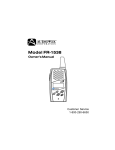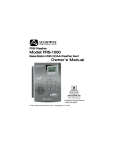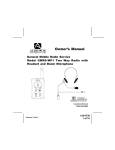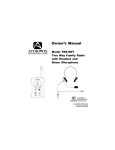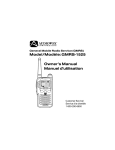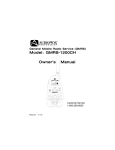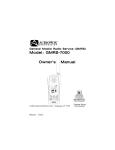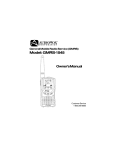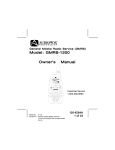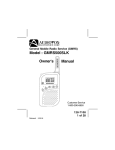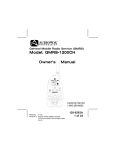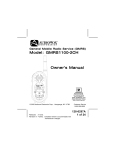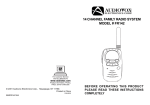Download Audiovox GMRS2000 Operating instructions
Transcript
GMRS/Weather Model: GMRS-2000 General Mobile Radio Service Base Station With NOAA Weather Alert Owner’sManual Customer Service/Service 1-800-290-6650 CAUTION NEVER ATTEMPT TO CHARGE ALKALINE OR DRY CELL BATTERIES. WHEN RECHARGING, USE ONLY AUDIOVOX APPROVED RECHARGEABLE BATTERIES AND CHARGER. USE OF THE CHARGER WITH OTHER BATTERIES WILL CAUSE DAMAGE TO YOUR GMRS-2000 TRANSCEIVER. OTHER TYPES OF BATTERIES MAY BURST CAUSING PERSONAL INJURY. AVOID INSTALLING THE GMRS-2000 TRANSCEIVER IN AN AREA WHERE IT MAY BE SUBJECTED FOR PROLONGED PERIODS OF TIME TO DIRECT SUNLIGHT OR TEMPERATURES BELOW -4° F (-20° C) OR ABOVE 140 ° F (60° C). KEEP THE ANTENNA (OR ANTENNA CABLE, IF INSTALLED) AT LEAST 1 INCH (2.5 cm) AWAY FROM YOUR HEAD AND BODY WHEN TRANSMITTING. DO NOT USE YOUR GMRS-2000 RADIO TRANSCEIVER WITH A DAMAGED ANTENNA. General Mobile Radio Service (GMRS) License: Use of THIS RADIO within the United States requires an FCC GMRS license. An individual 18 years of age or older, who is not a representataive of a foreign government, is eligible to apply for a GMRS system license. You will need two forms from the FCC; FCC Form 159 and FCC Form 605 Main Form and Schedule F. You can find the forms online at: http://www.fcc.gov/formpage.html, or call 1-800-4183676. 2 Model GMRS-2000 1 2 13 14 15 16 17 3 4 5 6 7 8 9 18 19 20 21 22 23 10 24 11 12 1. 2. 3. 4. 5. 6. 7. 8. 9. 10. 11. 12. 13. Battery Door (Right Rear Side) Battery Charging On/Off Switch Liquid Crystal Display (LCD) Weather Mode (WX) LED (Red) Antenna (Removable) Receive(Green)/Transmit (Red) LED MODE Button Voice-Operated Transmission (VOX) Button Weather (WX) Mode Button SCAN/LOCK Button Built-in Speaker Built-in Microphone DC Power Jack 3 25 14. 15. 16. 17. 18. 19. 20. 21. 22. 23. 24. 25. Weather Alert (ALT) LED (Red) Charging (CHG.) LED (Red) Up/Down CHANNEL Buttons Weather Alert (ALT) Button External Speaker(SPK)/Microphone (MIC) Jacks LCD Backlight/Monitor(L/MON) Button GMRS Mode Button VOX Audio Level Select Switch Power On/Off and Volume Control CALL Button Push-To-Talk (PTT) Button Emergency (EMG) Button Model GMRS-2000 DISPLAY 1 8 9 2 10 3 4 11 12 5 13 6 14 7 15 1. Button (Key) Tone Beep On/Off Indicator: This icon appears when the beep key tone is on, and disappears when tone is not in use. 2. Monitor Indicator: Icon appears when the Monitor (L/MON) button is pressed and the channel monitor function is activated. 3. Key Lock Indicator: Icon appears when keypad is locked. This function disables keys such as channel up/down and MODE. 4. Emergency Indicator: EMG icon appears when the EMG button is pressed. 5. Large Segment Display: Indicates the GMRS channel number in use. 6. Small Segment Display: Displays the CTCSS tone option (from 00-38) for the GMRS channel in use. 7. Scan Indicator: This function allows the user to scan a channel every .5 second to search for a valid signal. 8. Roger Beep Tone Indicator: Icon appears when the roger beep tone is enabled, signifying transmission has been terminated. Icon disappears when tone is disabled. 9. Battery Level Indicator: Icon indicates the battery charge level when the unit is operating under battery power. 4 10. GMRS Mode Indicator: Icon appears steady when GMRS mode is active; it disappears from display when weather mode is active. 11. HI/LO Indicators: Appropriate icon appears to identify the current transmit power level. 12. Signal Strength Indicator: Icon appears when a signal is being received. The icon consists of five bars to indicate the received signal level. The icon also represents transmit signal power when transmitting. 13. Voice Activated Transmission (VOX) Indicator: This function allows hands-free conversation. The icon appears when the VOX mode is activated. 14. Continuous Tone Coded Squelch System (CTCSS) Indicator: Displays in GMRS mode to indicate CTCSS code numbers. 15. Dual Watch Mode Indicator: Icon appears when dual watch mode is active. Powering the transceiver: The primary power source for Your GMRS-2000 base station is the AC wall adapter. The GMRS-2000 is also supplied with a battery back-up, should you experience loss of household current. The GMRS-2000 will automatically switch to battery back-up when AC power is interrupted. The rechargeable batteries, Part Number FRSRBAT, can be recharged in the radio transceiver using an AC charging adapter, which is also supplied with the unit. Installing the Back-Up Batteries: The five AA batteries are installed in the compartment at the right rear of the transceiver; the compartment is fitted with a removable cover. Install the batteries as follows: 1. Press down with the thumb at the arrow, and slide the battery cover off the side of the unit. 2. Insert the five AA rechargable batteries, Part Number FRSRBAT, provided. (Alternate positive ends (+) as shown in battery compartment layout.) Replace the cover. 5 BATTERY COMPARTMENT (WITH COVER REMOVED) BATTERY INSTALLATION POLARITY The following guidelines will improve performance and provide longer operating times for the GMRS-2000: 1. Do not mix old and new batteries. 2. Do not mix alkaline, standard (carbon-zinc) or rechargeable (Ni-MH) batteries. 3. If the unit is not to be used for an extended period of time, remove the batteries. Old or leaking batteries can cause damage to the unit and will void the warranty. Charging GMRS-2000 Batteries Part Number FRSRBAT : The rechargeable batteries, Part Number FRSRBAT, supplied with the unit, are charged by connecting the AC Adapter plug to the DC12V jack on the top of the unit, and setting the CHARGE switch to the ON position. Use only the AC Wall Adapter, Part Number GMRS2-AD, that is supplied with the base unit. The CHG. LED indicator below the LCD display lights red during battery charge operation. 6 The battery charge indicator icon displays the battery charge level when the AC adapter is unplugged. When the AC adapter is connected and in use, the indicator icon will indicate a full charge as shown below. Full Battery - three segments are illuminated. Low Battery - one segment is illuminated. Approximately 20-24 hours are required to fully charge the batteries. The red LED charging indicator (15) will light whenever the batteries are charging. A flashing red LED charging indicator denotes batteries are not installed. You must set the CHARGE switch to the OFF position when using any batteries other than the ones provided. Failure to do this may cause damage to batteries resulting in personal injury and/or damage to the unit. Caution: The charging adapter is intended for use with the supplied rechargeable batteries. Do not attempt to recharge any other type of batteries. CHARGE ON/OFF SWITCH AC ADAPTER ADAPTER PLUG BASE UNIT DC12V JACK 7 Controls: Power On/Off Volume Control (22) At the right side of the unit, rotate the VOL control counterclockwise (CCW) from the off detent position; you will hear a confirming melody to indicate the unit is on and the LCD display will perform a 2-second power-on selftest and then revert to the GMRS standby mode. To turn the unit off, rotate the VOL control clockwise (CW) to the off detent position. Adjusting the Volume With the unit powered on, rotate the VOL control CCW to increase volume and CW to decrease volume. Monitor/Display (L/MON) Button (19) This button is used to to check activity on the current frequency before transmitting. Check activity by pressing the Monitor (L/MON) Button longer than 2 seconds; the icon will apppear on the display and you will hear static if frequency is clear. Do not transmit if you hear conversation. Hold down the Monitor Button again longer than 2 seconds and the icon will disapppear from the display. The monitor function will temporarily bypass the squelch setting and play all signals on a given channel. This feature is useful when communicating with other parties at extreme range. By pressing the L/MON button momentarily, the LCD backlight is turned on; the LCD backlight will turn off automatically in about 5 seconds, or when the L/MON button is pressed momentarily once again. Push To Talk (PTT) Button (4) Pressing and holding this button will allow you to speak to any transceiver that is set to the same channel and privacy code setting as yours. After you have finished speaking, release the PTT Button to allow reception of incoming signals. It is not possible to transmit and receive at the same time. The Receive/Transmit (RX/TX) LED at the lower left corner below the LCD Panel (8) will light red while the PTT Button is pressed, and the signal strength indicator will display the relative strength of the transmitted signal. Releasing 8 the button allows the unit to revert to standby mode. When receiving an incoming signal, the received signal strength indicator ( ) will display the relative strength of the signal, and the TX/RX LED indicator will light steady green when a signal is being received, or will flash when in standby receive mode. Call Button (14) The CALL Button can also be used as a two-way call ringer. Pressing the button will call another party on the same channel. The RX/TX LED will light red for approximately 3 seconds and then go out; the RX/TX LED will then light green and/or flash if in standby receive mode. The display will indicate ) while the signal is transmitted. ( Up Channel Button (10) In the GMRS standby mode, pressing this button ( ) will increment the basic GMRS channel number; in weather mode, this button will also increment the weather channel number. When in function edit mode, this button is also used to adjust the unit’s settings. Down Channel Button (10) In the GMRS standby mode, pressing this button ( ) will decrement the basic GMRS channel number; in weather mode, this button will also decrement the weather channel number. When in function edit mode, this button is also used to adjust the unit’s settings. Mode Button (11) This button is used to select various feature settings in the GMRS mode only; mode settings for the weather band(s) are accomplished after the weather feature has been selected using the WX button and the associated CHANNEL Up/Down and Alert (ALT) buttons. Emergency (EMG) Call Button (24) This radio has a quick access button (EMG) to Emergency and Assistance Channel 10. This channel is not monitored by local authorities. When the EMG button is pressed, EMG appears on the display and the transceiver is set to channel 10, which operates at a frequency of 462.6750 MHz. 9 External Speaker (SPK)/Microphone (MIC) Jacks (6) This set of jacks accepts an Audiovox headset/microphone connector. Refer to GMRS Operational Modes. Scan/Lock Mode Button (12) Press this Button momentarily to enable or disable the scan mode. Press and hold Button for more than 1 second to lock or unlock keypad functions, except PTT and Monitor (L/MON). When the keypad is locked, the ( ) icon will appear in the upper right corner of the display. GMRS Operation Channel Selection In order to communicate with other GMRS units, both transmitting and receiving party must be on the same frequency. The GMRS-2000 has 15 channels (frequencies) indicated by the large digits on the LCD display panel. Channels 1-7 are also compatible with the Family Radio Service (FRS) communication channels, thereby allowing 2-way communication with other FRS units. Before transmitting on the selected channel, press the Monitor (L/MON) Button (2) to check the activity on that channel. If there is activity on the selected channel, wait until the channel is clear. To change the GMRS channel: - From GMRS standby mode, press the Up Button ( ) briefly to move to the next higher main channel number. - Press the Down Button ( ) briefly to move to the next lower main channel number. VOX Selection This option enables you to have hands-free conversation. Your voice or nearby sound is detected and the radio transmits without the need to press the PTT button. To set radio for VOX operation: - From GMRS standby mode, press the VOX button; the VOX icon appears steady on the display. 10 - At the right side of the unit, select the desired VOX sensitivity level by setting the VOX switch to LO, MID or HI position. - Momentarily press the VOX button to discontinue the VOX mode. NOTE: When the unit is transmitting in the VOX mode, no functions on the unit will operate. To regain control of the functions, it may be necessary to reduce ambient noises. Scan Operation This feature allows you to monitor all channels and tone codes (CTCSS) automatically for valid signals. When the unit is in the scan mode, a received signal will be audible for 10 seconds before the unit resumes channel scanning. To remain on a particular channel, press the SCAN or the PTT button. The weather alert function will be disabled in when the unit is in the scan mode. To enable the channel scan mode: - From GMRS standby mode, momentarily press the SCAN Button; (SCAN) will appear on the LCD display. The radio will display each channel (1-15) in order as the scan mode operates to find an active main channel. - To exit the scan mode, press the SCAN button momentarily and the unit will return to normal operation; (SCAN) icon will disappear from the LCD display. Key Pad Lock This feature prevents accidental change to the preferred settings of the unit. The Key Pad Lock function temporarily disables all buttons except the PTT, CALL and Monitor Buttons. To lock or unlock the Key Pad: - From the GMRS standby mode, press and hold the SCAN button for over 2 seconds to Lock the Key Pad; the ( ) icon appears on the display. 11 - To unlock the Key Pad, press and hold the SCAN button for at least 2 seconds; the ( ) icon disappears from the display. The PTT and Monitor Buttons are not effected. Weather Band Operation Channel Selection This feature provides access to 10 receive only channels within the weather band (7 NOAA channels and 3 Canadian marine channels). To change the channel: - From the GMRS standby mode, momentarily press the WX button; the receive icon ( ) will appear, together with a channel number in the band. - Press the Up button briefly to move to the next higher main channel number. - Press the Down button briefly to move to the next lower main channel number. Weather Alert The weather alert mode notifies the user of unusual weather situations. If the unit is in the GMRS mode when a weather alert signal is received, the unit will tune to the weather radio mode automatically, and will interrupt GMRS operation and play an Emergency weather message when one is transmitted on the selected channel. The unit will then revert to the selected weather channel for monitoring purposes. If the unit is in the weather radio mode when a weather alert signal is received, the unit will generate a warning beep tone. To silence the warning tone, press any key except the PTT button. To access the weather alert function: - Press the ALT button; the ALT LED lights red. 12 In GMRS mode, after approximately 10 seconds, the RX/TX and WX indicators begin to flash sequentially, indicating that the weather alert mode is active and is sampling the selected channel. - Momentarily press the ALT button again to exit the weather alert function. GMRS Menu Functions Refer to the illustration on following page for a graphic representation of the various menus. Continuous Tone Coded Squelch System (CTCSS) Mode (SubChannel) Selection The Coded Tone Controlled Squelch System (CTCSS) consists of 38 Sub-Frequencies. This feature allows you to utilize the coded squelch tones (01-38) within each main channel (1-15). This enables you to communicate with another party on the same main channel using the same subcode. (The CTCSS filters out unwanted transmissions without the same coded squelch tone.) Each of the 15 GMRS channels may be set independently. Tune the unit to the desired channel before setting the CTCSS code. To change the CTCSS Sub-channel: - From the GMRS standby mode, press the MODE button once; a flashing CTC icon and sub-channel number is displayed. - Press the CHANNEL Up or Down button to select the desired subchannel for use. The CTC icon will continue flashing with the subchannel number. - Momentarily press the PTT button to confirm selection, or simply wait approximately 10 seconds for the selection to affirm by itself. The CTCSS mode can be turned off by selecting 00 with the Up or Down button. 13 GMRS-2000 OPERATIONAL MODES GMRS BAND MODE SWITCH CTCSS SELECT XMIT POWER SELECT DUAL WATCH CHAN SELECT DUAL WATCH CTCSS SELECT KEY TONE BEEP ROGER BEEP CALL SELECT NOTE: To switch between GMRS and Weather Band modes, momentarily press the WX button (for weather operation), or the GMRS button (for GMRS operation). To differentiate between operating modes, look for the GMRS indicator. In Weather Band mode, the GMRS indicator is not present. Refer to the appropriate section of this manual for detailed operating instructions for each mode. When in GMRS standby mode, the RX/TX LED indicator will flash once a second as the unit checks for transmissions. 14 NOTE: To communicate with other FRS or GMRS units, they must be switched to the same channel and CTCSS subcode. To communicate with other FRS units that do not have subcodes, switch your unit to the same channel with the subcode set to 00. The CTCSS subcodes do not prevent others from hearing your transmission. This will only allow you to ignore all traffic on a given channel not using the same subcode. Transmit Power Selection Mode This feature permits selection of the transmitting power level at high or low. When set to low, the transmit range of the unit will be less; however, battery life will be increased. Each of the 15 GMRS channels may be set independently. Tune to the desired GMRS channel before setting the power level. To access the transmitter power selection function from the GMRS mode: - Press the Mode Button twice; a HI or Lo indication appears flashing on the display. - Press the Up or Down button to toggle between the High and Low selections. - Momentarily press the PTT Button to confirm selection, or simply wait approximately 10 seconds for the selection to affirm by itself. The display will indicate the current channel setting in standby mode. Dual Watch Mode This feature allows you to monitor two special channels. While in dual watch mode, the unit will continuously monitor both the primary and dual watch channel. Received signals will be played for 5 seconds then the other channel will be scanned. Pressing the PTT button during a received transmission will set the unit to transmit on the same channel. Pressing the PTT button when no signal is received will set the unit to transmit on the primary channel. The weather alert function will be disabled in the dual watch mode. The dual watch mode will automatically terminate when the unit transmits. 15 To set the Dual Watch Mode: - From the GMRS standby mode, press the MODE button 3 times; the DW icon flashes on the display, together with the channel number currently selected. - To enable the dual watch mode, press the Up or Down button; the dual watch channel number will flash and start to increment up or down as the Up or Down button is pressed. The DW icon appears steady on the display. Dual Watch CTCSS Mode - Press the MODE button again to enter the dual watch channel CTCSS function and select the desired CTCSS code for the dual watch chan nel previously entered. - Press the SCAN button to confirm selection of the dual watch channel. The display will now alternate between the primary channel and the dual watch channel just selected. The DW icon appears steady on the display. Momentarily press the PTT button to exit the dual watch selection mode. Key Tone Selection Mode This feature allows the transceiver to sound a tone whenever the following keys are pressed: Monitor (L/MON) Button, CHANNEL Up/Down Buttons, MODE Button, or SCAN Button. To turn the key tones on or off: - From the GMRS standby mode, press the MODE Button 5 times until bp, the Bell ( ) icon, and On or oF flash on the LCD display. - Press the Up or Down Button to toggle the key tone feature On or Off. - Momentarily press the PTT button to confirm your selection. When the key tone feature is on, the Bell icon appears steady on the display, and the beep tones sound in response to each button activation. 16 Roger Beep Tone The Roger Beep is a tone which is automatically transmitted whenever the PTT button is released . This tone alerts the receiving party that the transmission has been terminated intentionally. To enable and disable the Roger Beep tone: - Press the Mode Button 6 times until ( r ) appears on the display with the flashing Roger Beep icon ( ) and the on or oF indication. - Press the Up or Down Button to select the tone on or off as desired. - When enabled, the tone icon ( ) appears steady on the display. - Momentarily press the PTT Button to confirm selection. Call Ringer Selection Mode The transceiver provides 5 user-selectable call ringer melodies that alerts other users that you want to communicate with them. To select your favorite call ringer melody: - From the GMRS standby mode, press the MODE button 7 times; CA will appear on the display, together with a flashing number between 1 and 5, and ring will sound. - Press the Up or Down Button to preview the 5 available call melodies. - Momentarily press the PTT button to confirm your selection. Additional Functions When the battery ( ) icon appear(s) flashing on the LCD panel, recharge unit or install new Audiovox approved rechargeable batteries. The unit will also provide an audible warning of low battery voltage. If this icon continues to flash on the LCD, please contact your authorized service center. Prior to contacting your authorized service center, please check the following: 1. Verify correct battery installation. 2. Install new Audiovox approved rechargeable batteries 3. Check that AC adapter is plugged into a working AC power outlet. 17 NOTES FOR GOOD COMMUNICATION 1 . The GMRS-2000 15 channels are shared on a ‘take turns’ basis. This means other groups may be talking on any of the channels. A common code of ethics/courtesy is to switch to another vacant channel and not to attempt to talk over someone who is already using the channel you first selected. 2. The GMRS-2000 has been designed to maximize performance and improve transmission range to field units. To avoid interference, it is recommended that you do not use base and field units closer than 5 feet apart. 3. For best transmission results, always keep your mouth about 2-3 inches from the microphone (12) and speak slowly in a normal voice. Warning • Remove the batteries from the transceiver if it is not expected to be used for long periods. This will eliminate the possibility of chemicals leaking from the batteries and corroding the transceiver. • Avoid exposing the transceiver to water or extremes of temperature. • Do not use this device in or near a mining facility, which uses remotely triggered explosives or in areas labeled “Blasting Area”. Premature or accidental detonation may result. • Do not attempt to modify or in any way increase the output of this transceiver. Its output is designed to meet the legal limits set by the FCC. • Do not use this device or change its batteries in potentially explosive atmospheres as sparks in such areas could result in an explosion. • Turn your transceiver off wherever posted notices restrict the use of radios or cellular telephones. Facilities such as hospitals may use equipment that is sensitive to RF energy. 18 Troubleshooting Problem Possible cause No transmission while pressing the PTT Button Weak batteries Incorrect battery polarity Weak or no signal received Weak batteries Channel and privacy code not set the same as target transceiver Volume level too low PTT Button inadvertently depressed Excessive radio interference on a particular channel Obstruction of radio signal Unit beeps, but will not function when turned on Reception of unwanted signals Batteries extremely discharged CTCSS privacy mode not on Interference from electronic devices such as computers or TVs Charge light flashes Correction Charge or replace batteries Install the batteries following the directions in paragraph Installing the Batteries. Charge or replace batteries Adjust the transceiver’s settings to match those settings of the target transceiver Increase volume level Release PTT Button Change to a different channel Avoid operating in or near large buildings or vehicles Charge or replace batteries Turn on the CTCSS privacy mode and set code number to match the setting of the target transceiver. Turn the devices off or move farther away from them. Batteries are not installed and Install Audiovox approved CHARGE switch (2) in the batteries or set the ON position CHARGE switch to OFF. 19 Technical Specifications: General Frequency Range: GMRS Weather Refer to chart on next page Refer to chart on next page Privacy Codes 38 for each main channel Dimensions (W x H x D) 6.7 in x 7.0 in x 2.6 in (Without Antenna) 170.0 mm x 177.0 mm x 66 mm Power Supply Power Source AC/DC Adapter Input: 120 Vac Output: 12 Vdc, 1.5 Amp Battery Backup Operating Time Battery Backup Rechargeable, AA (5), 6.0 VDC, 1300 mA 18 hours - NiMH (Transmit: Receive: Standby) (5: 5: 90 ratio) Receiver Useable Sensitivity >-119 dBm Maximum Audio Output Power > 300 mW (8 Ohm ) Modulation Distortion < 5% (1 kHz 70%) Transmitter Maximum RF Output Power: High 2.0 Watt Low 0.5 Watt maximum Range Up to 5 miles Maximum Deviation +/- 2.5 kHz Modulation Distortion < 5% (1 kHz 70%) 20 This transceiver complies with FCC regulations for use in the United States of America. Use in other countries may be prohibited or restricted by local regulation. Please check with the local regulating agency before using this device outside the United States of America. GMRS Channel Frequencies: Channel 1* 2* 3* 4* 5* 6* 7* Freq. MHz Channel 462.5625 462.5875 462.6125 462.6375 462.6625 462.6875 462.7125 8 9 10 11 12 13 14 15 Freq. MHz 462.5750 462.6250 462.6750 462.5500 462.6000 462.6500 462.7000 462.7250 * These frequencies correspond to FRS radio channels 1 through 7. Weather Channel Frequencies: Channel Freq. MHz 1 2 3 4 5 162.550 162.400 162.475 162.425 162.450 Channel 6 7 8* 9* 10* * Canadian Marine 21 Freq. MHz 162.500 162.525 161.650 161.775 163.275 Continuous Tone Coded Squelch System Tone Frequencies (in Hz) CTCSS Freq. Hz CTCSS 01 02 03 04 05 06 07 08 09 10 11 12 13 14 15 16 17 18 19 67.0 71.9 74.4 77.0 79.7 82.5 85.4 88.5 91.5 94.8 97.4 100.0 103.5 107.2 110.9 114.8 118.8 123.0 127.3 20 21 22 23 24 25 26 27 28 29 30 31 32 33 34 35 36 37 38 00 = No Tone 22 Freq. Hz 131.8 136.5 141.3 146.2 151.4 156.7 162.2 167.9 173.8 179.9 186.2 192.8 203.5 210.7 218.1 225.7 233.6 241.8 250.3 90 DAY LIMITED WARRANTY Applies to Audiovox Family Radio and General Mobile Service Products. AUDIOVOX CORPORATION (the Company) warrants to the original retail purchaser of this product that should this product or any part thereof, under normal use and conditions, be proven defective in material or workmanship within 90 days from the date of original purchase, such defect(s) will be repaired or replaced with new or reconditioned product (at the Company's option) without charge for parts and repair labor. To obtain repair or replacement within the terms of this Warranty, the product is to be delivered with proof of warranty coverage (e.g. dated bill of sale), specification of defect(s), transportation prepaid, to the warranty center at the address shown below. The Company disclaims liability for communications range of this product. This Warranty does not apply to any product or part thereof which, in the opinion of the Company, has suffered or been damaged through alteration, improper installation, mishandling, misuse, neglect, accident, or by removal or defacement of the factory serial number/bar code label(s). THE EXTENT OF THE COMPANY'S LIABILITY UNDER THIS WARRANTY IS LIMITED TO THE REPAIR OR REPLACEMENT PROVIDED ABOVE AND, IN NO EVENT, SHALL THE COMPANY'S LIABILITY EXCEED THE PURCHASE PRICE PAID BY PURCHASER FOR THE PRODUCT. This Warranty is in lieu of all other express warranties or liabilities. ANY IMPLIED WARRANTIES, INCLUDING ANY IMPLIED WARRANTY OF MERCHANTABILITY, SHALL BE LIMITED TO THE DURATION OF THIS WRITTEN WARRANTY. ANY ACTION FOR BREACH OF ANY WARRANTY HEREUNDER INCLUDING ANY IMPLIED WARRANTY OF MERCHANTABILITY MUST BE BROUGHT WITHIN A PERIOD OF 30 MONTHS FROM DATE OF ORIGINAL PURCHASE. IN NO CASE SHALL THE COMPANY BE LIABLE FOR ANY CONSEQUENTIAL OR INCIDENTAL DAMAGES FOR BREACH OF THIS OR ANY OTHER WARRANTY, EXPRESS OR IMPLIED, WHATSOEVER. No person or representative is authorized to assume for the Company any liability other than expressed herein in connection with the sale of this product. Some states do not allow limitations on how long an implied warranty lasts or the exclusion or limitation of incidental or consequential damage so the above limitations or exclusions may not apply to you. This Warranty gives you specific legal rights and you may also have other rights which vary from state to state. AUDIOVOX CORPORATION, 150 MARCUS BLVD., HAUPPAUGE, NEW YORK 11788 128-5385A 1-800-290-6650 23 © 2001 Audiovox Electronics Corp., Hauppauge, NY 11788 Printed in Korea 128-6037
























